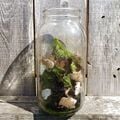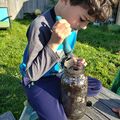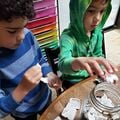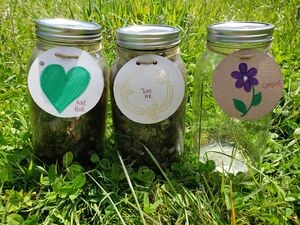
I wanted to implement my own at-home kid-friendly 3 bin composting system.The objective of this project is to make a small-scale at home composting system that will be easy, low-cost, instructive, and educational to children while diverting food waste and other compostable materials from the landfill. There is virtually no construction involved in this project. Using this system is very easy and relatively maintenance free. The microbes in the compost are doing most of the work! Our family has really enjoyed this composting project it was fun and educational.
Background[edit | edit source]
After learning the basics of composting from the CCAT Compost System 2020 project I wanted to implement my own at-home kid-friendly 3 bin composting system. I wanted a system that was an appropriate size for the amount of food waste/compostable materials we generate in our household, I wanted it to be safe and kid-friendly so I could involve them in the process, and I wanted it to be educational for my children. This system was created in the spring of 2020 in Northern California, USA.
Problem statement[edit | edit source]
The objective of this project is to make a small-scale at home composting system that will be easy, low-cost, instructive, and educational to children while diverting food waste and other compostable materials from the landfill.
Criteria[edit | edit source]
The following criteria were instrumental when determining which compost system I would use at home and why.
| Criteria | Constraints | Weight (1-10) |
|---|---|---|
| Educational Value | Must be able to provide an understanding of the composting process easily for young children | 10 |
| Maintainability | Simplicity in design and maintenance to maintain children's interests | 9 |
| Cost | Staying under budget. | 10 |
| Ease of Use | Must be suitable for people of all ages, including children under 5, without supervision | 9 |
| Longevity | System should be able to be used as a long term addition to a single-family home | 8 |
Prototyping[edit | edit source]
Here is the initial idea and design of the 3 jar at home composting system.
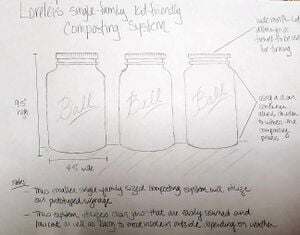
Construction[edit | edit source]
There is virtually no construction involved in this project. I purchased the mason jars at the local hardware store. I made the signs from recyclable cardboard - I used the lid of the mason jar as a trace for the size of the sign and then drew the images on each of the signs I made. I tied the signs onto the jars using twine that I already had at home.
Costs[edit | edit source]
Because this at home project came about unexpectedly and during the pandemic I was hoping to use as much as possible from materials I already had at home without having to go out and visit more than one store for any necessary items. I was hoping to stay under a budget of $30 for the entire system. I was happy to learn that our local hardware stores carries many sizes of glass mason jars that are well-priced (and well below budget). I was able to source everything else that this kid-friendly compost system would need from supplies I already had at home. If I had needed a trowel, that would've been something I could've gotten at the hardware store as well and still been below budget.
| Quantity | Material | Source | Cost ($) | Total ($) |
|---|---|---|---|---|
| 3 | 64oz Glass Mason Jars | Local Hardware Store | $3.49 | $10.47 |
| 3 | Jar Signs | Recycled cardboard | $0 | $0 |
| 3 | 12" sections of twine | Already had | $0 | $0 |
| 1 | Trowel | Already had | $0 | $0 |
| Total Cost | $10.47 | |||
Operation[edit | edit source]
This is how to use your 3 jar compost system with kids, why I did this compost system, and things to know:
Schedule[edit | edit source]
Using this system is very easy and relatively maintenance free. The microbes in the compost are doing most of the work! I currently follow this schedule:
- Daily
- Add food scraps/compostable materials as they arise
- As you add the food scraps, be sure to maintain proper N:C ratios of waste to the system.
- Weekly
- Turn compost briefly using trowel or other appropriate gardening tools.
- Tear up recyclable cardboard or egg cartons to be used as carbon
- Switch over signs as needed.
- Monthly
- Prepare to harvest compost after decomposed. It will be much lighter in weight and airy and you should see little food scraps remaining.
- Empty out and clean jars using water.
Compost System Progress[edit | edit source]
Here are some images of progress steps along the way to creating and using our compost system at home.
- Compost System Gallery
-
The first food scraps get added to the first jar.
-
The first jar is almost full.
-
Inside look at the compost in the first jar and trowel.
-
Kids using the trowel to stir the first jar.
-
Signs made for the 3 different jars.
-
The "add food" sign has been moved to the second jar.A new add jar is starting.
-
Kids adding carbon to the compost, as new food scraps are added in, to maintain proper N:C.
-
The 3 jar system in it's current state with one jar processing and one jar almost full. Looking forward to finished compost in the next few weeks.
Conclusion[edit | edit source]
Our family has really enjoyed this composting project. My children often ask about it and ask if they can turn it. It has been a very educational experience. Once the finished compost is ready and we use it as an additive in our garden they will have seen the process in it's entirety and we can talk about the overall effects we've had on the planet with this small composting project.
Lessons learned[edit | edit source]
I think that I may want to go a little bigger on the jars. I think that I'm filling the jars up a little too quickly for how long it will take a full jar to process into finished compost. The trade-off with larger jars would be that they're less easy to move, heavier, and would need longer tools to reach the bottom to turn.
Next steps[edit | edit source]
We will continue adding our food waste and other compostable materials into the jars (along with additional carbon to maintain N:C ratios). The processing jar will continue to decompose and I will document how long it takes for a jar to turn into finished usable compost.

